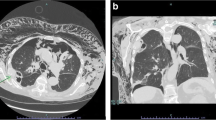Abstract
The treatment of hidradenitis suppurativa is challenging. Recently, cryoinsufflation was described for treating this perplexing condition. We hereby report the occurrence of pneumomediastinum, pneumothorax, and extensive subcutaneous emphysema following the treatment of sternal hidradenitis suppurativa by cryoinsufflation. These complications were gradually resolved spontaneously under careful observation. Notwithstanding that the trapped gas in the subcutaneous and lung tissues in our patient gradually reabsorbed spontaneously, we are now in the opinion that cryoinsufflation in the thorax area should be performed under deep sedation or general anesthesia, with close observation of the patient including overnight hospitalization and monitoring by oximetry. Alternatively, the use of different cryosurgery techniques such as contact or intralesional methods could be considered.
Level of evidence: Level V, risk study


Similar content being viewed by others
References
Zouboulis CC, Desai N, Emtestam L, Hunger RE, Ioannides D, Juhász I, Lapins J, Matusiak L, Prens EP, Revuz J, Schneider-Burrus S, Szepietowski JC, van der Zee HH, Jemec GB (2015) European S1 guideline for the treatment of hidradenitis suppurativa/acne inversa. J Eur Acad Dermatol Venereol 29:619–644
Graham GF, Barham KL (2003) Cryosurgery. Curr Probl Dermatol 15:223–250
Ritz J-P, Runkel N, Haier J, Buhr HJ (1998) Extent of surgery and recurrence rate of hidradenitis suppurativa. Int J Color Dis 13:164–168
Mehdizadeh A, Hazen P, Bechara FG, Zwingerman N, Moazenzadeh M, Bashash M, Sibbald RG, Alavi A (2015) Recurrence of hidradenitis suppurativa after surgical management: a systematic review and meta-analysis. J Am Acad Dermatol 73:S70–S77
Bong JL, Shalders K, Saihan E (2003) Treatment of persistent painful nodules of hidradenitis suppurativa with cryotherapy. Clin Exp Dermatol 28:241–244
Pagliarello C, Fabrizi G, Feliciani C, Di Nuzzo S (2014) Cryoinsufflation for Hurley stage II hidradenitis suppurativa: a useful treatment option when systemic therapies should be avoided. JAMA Dermatol 150:765–766
Pagliarello C, Fabrizi G, Di Nuzzo S (2016) Cryoinsufflation for Hurley stage II hidradenitis suppurativa: technical refinement to prevent complications. Dermatol Surg 42:130–132
Vano-Galvan S, Bagazgoitia L, Perez B, Jaen P (2008) Subcutaneous emphysema caused by cryotherapy application over a corticosteroid-induced atrophic skin. J Eur Acad Dermatol Venereol 22:508–509
Sánchez-Martín J, Vázquez-López F, Gómez-Díez S, Pérez-Oliva N (2008) Benign subcutaneous emphysema after a skin biopsy. Dermatol Surg 34:1141–1142
Singal A, Yadav P, Pandhi D (2013) Benign subcutaneous emphysema following punch skin biopsy. J Cutan Aesthet Surg 6:171–172
Lambert TJ, Wells MJ, Wisniewski KW (2006) Subcutaneous emphysema resulting from liquid nitrogen spray. J Am Acad Dermatol 55(5, supplement):S95–S96
Choy MC, Pescod D (2007) Pneumothorax in association with spontaneous ventilation general anaesthesia—an unusual cause of hypoxaemia. Anaesth Intensive Care 35:270–273
McDermott R., Tsang K., Hamilton N., Belton M., Recreational nitrous oxide inhalation as a rare cause of spontaneous pneumomediastinum. BMJ Case Rep. 2015 Sep 21; 2015
Light R.W., Pleural diseases. Lippincott Williams & Wilkins (5th ed.), p. 310, 2007
MacDuff A, Arnold A, Harvey J, BTS Pleural Disease Guideline Group (2010) Management of spontaneous pneumothorax: British Thoracic Society pleural disease guideline 2010. Thorax 65(8):ii18–ii31
Baumann MH, Strange C, Heffner JE, Light R, Kirby TJ, Klein J, Luketich JD, Panacek EA, Sahn SA (2001) Management of spontaneous pneumothorax: an American College of Chest Physicians Delphi consensus statement. Chest 119:590–602
Jeavons RP, Dowen D, Rushton PRP, Chambers S, O'Brien S (2014) Management of significant and widespread, acute subcutaneous emphysema: should we manage surgically or conservatively? J Emerg Med 46:21–27
Har-Shai Y, Amar M, Sabo E (2003) Intralesional cryotherapy for enhancing the involution of hypertrophic scars and keloids. Plast Reconstr Surg 111:1841–1852
Har-Shai Y, Sommer A, Gil T, Krausz J, Gal-Or N, Mettanes I, Lavi I, Eyal N, Brizgalin L, Taran A, Har-Shai L, Elmalach I (2016) Intralesional cryosurgery for the treatment of basal cell carcinoma of the lower extremities in elderly subjects: a feasibility study. Int J Dermatol 55:342–350
Martínez-Coronado J, Torres-Álvarez B, Castanedo-Cázares JP (2015) Subcutaneous emphysema induced by cryotherapy: a complication due to previous punctures. Case Rep Dermatol Med 2015:374817
Acknowledgment
The authors extend their appreciation to Professor Emeritus B. Hirshowitz FRCS for his help in editing this manuscript for publication.
Author information
Authors and Affiliations
Corresponding author
Ethics declarations
Ethical standards
For this type of study formal consent from a local ethics committee is not required.
Conflict of interests
A. Kramer, I. Metanes, N. Eyal, L. Brizgalin, S. Halabi, L. Har-Shai, Y. Har-Shai declare that they have no conflict of interest.
Patient consent:
Patient provided written consent before her inclusion in this study. Additional consent was obtained for the use of her images.
Funding
None
Additional information
I. Metanes equally contributed as the first author.
Rights and permissions
About this article
Cite this article
Kramer, A., Metanes, I., Eyal, N. et al. Pneumomediastinum, pneumothorax and subcutaneous emphysema following cryoinsufflation for the treatment of hidradenitis suppurativa. Eur J Plast Surg 40, 71–74 (2017). https://doi.org/10.1007/s00238-016-1230-6
Received:
Accepted:
Published:
Issue Date:
DOI: https://doi.org/10.1007/s00238-016-1230-6




